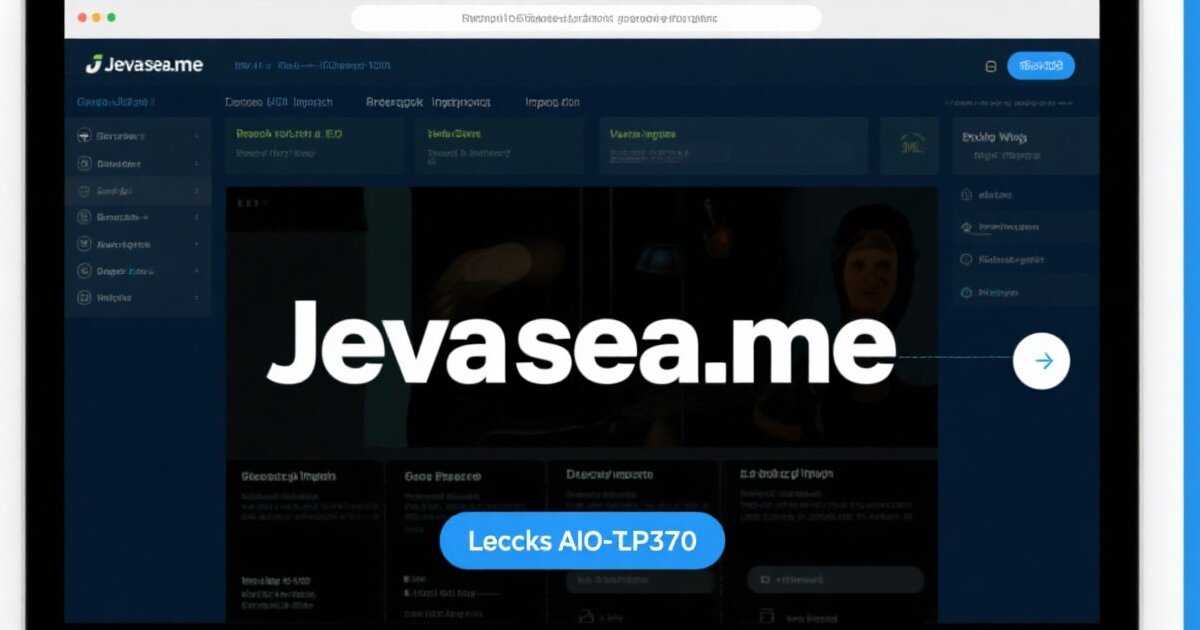1. Introduction: A Shockwave in Cybersecurity
March 2025 marked one of the most startling cybersecurity events of the decade — the TheJavaSea.me AIO-TLP370 leak. What began as quiet murmurs on developer forums soon erupted into a full-blown global incident, exposing over 1.2GB of sensitive proprietary source code, credentials, and internal documents. The leaked package, allegedly named aio-tlpfullv7.3.zip, was first shared on obscure paste sites before making its way to GitHub and Discord developer communities.
The severity of this breach wasn’t just about data theft — it was about trust. The AIO-TLP platform was a cornerstone of enterprise logging and monitoring systems, used by thousands of organizations worldwide. Its compromise meant that critical parts of global cyber infrastructure were suddenly vulnerable.
This article explores what happened, what was leaked, who is affected, and most importantly, how businesses and individuals can respond. By understanding the depth of the AIO-TLP370 breach, organizations can learn how to fortify themselves against the next inevitable cyber shockwave.
2. What Is AIO-TLP370?
AIO-TLP, short for All-In-One Transparent Log Processor, is a high-performance enterprise system designed to aggregate, analyze, and visualize log data in real time. It played a vital role in compliance automation, anomaly detection, and DevOps observability, making it a go-to solution for security operations centers (SOCs) and cloud infrastructure teams.
Before the leak, AIO-TLP enjoyed a stellar reputation among cybersecurity experts and system architects. It streamlined log ingestion across multiple platforms, from AWS and Azure to Kubernetes clusters, offering unmatched transparency and automation.
The leaked version 370 (AIO-TLP370) was particularly advanced — featuring machine learning-based threat analytics, modular data connectors, and API-driven extensions. Unfortunately, these very innovations made the breach more dangerous. Once celebrated for its efficiency, AIO-TLP370 became a symbol of how a single vulnerability can unravel even the strongest digital ecosystems.
3. Timeline of the Leak: From Discovery to Fallout
- March 22, 2025: The first mention of the archive
aio-tlpfullv7.3.zipappeared on a small paste-sharing platform. - March 24, 2025: Fragments surfaced on GitHub Gists and Discord developer channels, sparking curiosity in cybersecurity circles.
- March 26, 2025: Independent analysts confirmed the files were authentic components of the AIO-TLP system.
- April 2025 onward: The leak gained traction on the dark web. Security firms worldwide began investigations, revealing exposed credentials, proprietary algorithms, and confidential documentation.
Within days, the data spread across multiple public and private repositories, making containment impossible. Cyber intelligence groups reported that the leak was being repackaged and traded on underground marketplaces, intensifying the risk for organizations using similar infrastructures.
4. Inside the Leak: What Was Exposed
The leaked archive was far more than a simple code dump. It included multiple layers of critical data:
- Source Code: Revealed proprietary log parsers, ML models, and data connectors exposing system architecture.
- Configuration Files: Contained embedded API keys, OAuth tokens, and internal service endpoints.
- Internal Playbooks: Documented detailed incident response plans and escalation workflows.
- Developer Notes & Roadmaps: Exposed future feature plans, including AI-based automation modules and container-native updates.
- Operational Logs: Held metadata capable of revealing client activity patterns.
🔍 New Insight: Analysts discovered traces of “hidden variables” tied to sandbox and testing environments. This increases risk for organizations that reused code or configurations from these environments, potentially allowing attackers to map real-world infrastructures.
5. Who Is Behind TheJavaSea.me Leak?
The origin of the TheJavaSea.me leak remains uncertain, but two leading theories dominate the discussion:
- Disgruntled Insider: A former developer or contractor leaking sensitive data for revenge or financial motivation.
- Supply Chain Compromise: A sophisticated external attack exploiting a third-party integration to extract internal files unnoticed.
Adding intrigue, TheJavaSea.me operates under the cryptic motto, “Unveiling hidden tech that shapes digital reality.” Intelligence reports suggest possible links to a network of data exposure campaigns in 2025 targeting software supply chains.
This aligns with a growing pattern — not isolated breaches, but coordinated data exposure operations aimed at disrupting digital trust and extracting corporate secrets.
6. The Real-World Impact of the AIO-TLP370 Leak
For Individuals
- Exposure of personal data and credentials.
- Increased risk of phishing, identity theft, and scam campaigns referencing the breach.
- Potential misuse of authentication data in credential stuffing attacks.
Businesses
- Widespread supply chain vulnerabilities and cloud API misuse.
- Possible non-compliance with GDPR, HIPAA, and ISO security standards.
- Reputational damage leading to client distrust and financial loss.
For Developers & Security Teams
- The leak enables reverse engineering of the system, potentially revealing new zero-day vulnerabilities.
- Erosion of confidence in open-source and DevOps ecosystems.
The breach is now considered a benchmark case in supply chain compromise, showing how a single tool can trigger a cascade of global risks.
7. Key Vulnerabilities Revealed
The investigation uncovered several recurring weaknesses:
- Hardcoded Credentials: Exposed usernames, passwords, and tokens within repositories.
- Misconfigured CI/CD Pipelines: Build systems inadvertently publishing secrets.
- Poor Network Segmentation: Allowed lateral movement after initial compromise.
- Weak Authentication Models: Outdated access protocols failed to restrict privilege escalation.
- Unpatched Dependencies: Known vulnerabilities in open-source libraries exploited by attackers.
⚠️ Security analysts now warn that malicious actors may repurpose AIO-TLP modules into malware, embedding legitimate log analysis tools with hidden backdoors — making detection more difficult for security teams.
8. How Businesses Should Respond (Step-by-Step Framework)
- Audit & Scope: Identify whether AIO-TLP components are used within your infrastructure.
- Revoke Keys & Credentials: Replace all potentially exposed API keys, SSH certificates, and tokens.
- Patch & Isolate: Apply all updates and segregate logging servers from production.
- Implement Zero Trust: Apply strict identity-based access controls across all systems.
- Conduct Forensic Analysis: Investigate intrusion points and assess exposure impact.
- Enhance Incident Response: Simulate breach scenarios to improve readiness.
- Collaborate with Vendors: Share threat intelligence with supply chain partners to strengthen collective defense.
These actions not only mitigate damage but also build long-term resilience against evolving threats.
9. Lessons in Supply Chain and Open-Source Security
The AIO-TLP370 breach highlights the ripple effect of interconnected systems. Modern software ecosystems depend on third-party components, meaning one weak link can compromise an entire chain.
Key lessons:
- Regularly perform third-party risk assessments.
- Maintain an accurate Software Bill of Materials (SBOM) for all deployments.
- Use signed commits and encrypted build pipelines to ensure code integrity.
- Explore blockchain-based provenance verification to track code authenticity.
This event reinforces a critical truth: transparency and traceability are the future cornerstones of secure software development.
10. Legal, Ethical, and Privacy Dimensions
Downloading or redistributing leaked data is illegal under most global jurisdictions, including the EU and U.S. cyber laws. Journalists and researchers must handle such materials responsibly, reporting findings without exposing sensitive assets.
Global standards like the EU AI Act and NIST SP 800-218 (Secure Software Development Framework) demand accountability from developers and vendors in securing their codebases.
Ethical cybersecurity practices require balancing transparency and privacy — ensuring that while incidents are studied and reported, sensitive data is never further exposed.
11. Preventive Strategies: How to Stay Secure
For Users
- Change all passwords immediately and enable multi-factor authentication (MFA).
- Use a password manager for unique logins.
- Monitor banking and online activity for suspicious behavior.
Developers
- Deploy automated secret scanning in repositories.
- Use dedicated secret managers like HashiCorp Vault or AWS Secrets Manager.
- Enforce role-based access and limit credential lifespans.
For Organizations
- Implement continuous monitoring systems (SIEM, EDR, SOAR).
- Conduct quarterly red-team exercises.
- Communicate transparently with clients and stakeholders post-breach.
12. A Look Ahead: The Future of Cyber Defense Post-AIO-TLP370
The AIO-TLP370 incident will likely reshape global cybersecurity frameworks. Expect greater adoption of:
- AI-driven threat detection that learns from real breaches.
- Immutable logging and quantum-safe encryption for long-term data protection.
- Decentralized monitoring frameworks, reducing single points of failure.
While the AIO-TLP project may not recover, its downfall serves as a catalyst for developing more resilient, privacy-focused successors.
13. Conclusion: Turning Crisis into Catalyst
The TheJavaSea.me AIO-TLP370 leak is more than a cautionary tale — it’s a defining event for the cybersecurity community. It exposed systemic weaknesses, tested global response mechanisms, and reminded us that no technology is immune to compromise.
True resilience lies in adaptation and learning. As the digital world grows more interconnected, transparency and collaboration will be essential for defending against future threats.
“Leaks like TheJavaSea.me AIO-TLP370 remind us that resilience is built not by avoiding failure, but by learning from it.”
14. FAQs (SEO Section)
Q1: What is TheJavaSea.me AIO-TLP370 leak?
A massive March 2025 data breach exposing AIO-TLP’s proprietary source code, internal documentation, and credentials.
Q2: Who was affected by the leak?
Organizations using AIO-TLP components, developers, and integrated vendors worldwide.
Q3: Is it safe to download leaked data?
No. Accessing or redistributing leaked data is illegal and poses cybersecurity risks.
Q4: What steps can I take to protect myself?
Change passwords, enable MFA, and use secure password managers. Businesses should revoke exposed credentials and update systems.
Q5: How can companies strengthen their cybersecurity after such breaches?
Adopt zero trust architecture, implement continuous monitoring, and perform regular red-team simulations.










